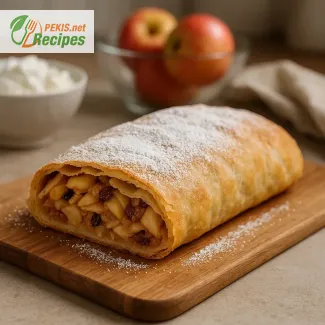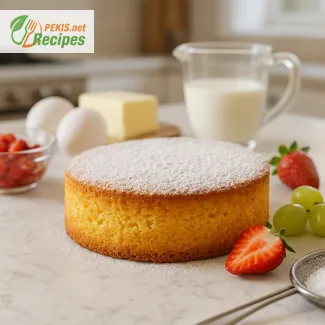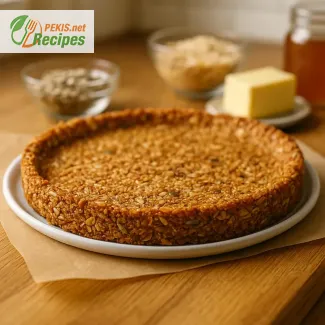
Authentic homemade Apfelstrudel with traditional Viennese flair
A timeless Austrian dessert that celebrates thin dough, spiced apples, and golden crispness
The Classic Viennese Apple Strudel stands as one of the most iconic and beloved desserts of Austrian cuisine, known for its delicate hand-stretched dough and aromatic apple filling. Originating in the imperial kitchens of Vienna, this dessert reflects centuries of culinary refinement, blending Middle European pastry traditions with regional ingredients and techniques passed down through generations. The version made entirely from scratch, using a paper-thin strudel dough rather than store-bought phyllo or puff pastry, is considered the most authentic and celebrated expression of this culinary heritage.
What sets the traditional Viennese strudel apart is not only the quality of its ingredients but also the method of preparation. The dough is painstakingly stretched by hand until it becomes almost translucent, a skill that demands both patience and precision. When baked, it transforms into a crispy, golden shell that envelops a tender, flavorful filling of apples, raisins, cinnamon, sugar, and often toasted breadcrumbs or crushed nuts. The contrast between the crisp outer layers and the moist, spiced interior makes every bite rich in texture and flavor.
Why making apple strudel from scratch matters
Preparing this dessert from scratch allows full control over every element—from dough texture to apple selection—leading to a far superior result than using shortcuts. While frozen doughs may offer convenience, they lack the elasticity and stretchability required to achieve the signature flaky layers that define the Viennese version. The homemade dough, when properly rested and stretched, results in an incredibly light structure that crisps perfectly in the oven while retaining a tender bite.
Moreover, making the dough by hand connects the baker to the ritual of traditional European pastry-making. The process itself is meditative and rewarding, often described as a form of edible craftsmanship. From mixing the flour and oil to gently pulling the dough across a floured cloth, each step enhances the final result.
The apple filling: choosing the right variety
Not all apples are created equal when it comes to strudel. Classic recipes favor firm, slightly tart apples like Granny Smith, Boskoop, or Braeburn, which hold their shape during baking and provide a pleasant contrast to the sweetness of the filling. These apples also release less moisture, helping to avoid soggy pastry bottoms. A good apple strudel should be juicy yet structured, with just enough softness to contrast the crunchy shell.
Spices are crucial to the flavor balance. Cinnamon is a must, but some traditional bakers also add a touch of clove, lemon zest, or even a dash of rum-soaked raisins to deepen the aroma. The filling is often combined with buttered breadcrumbs, which absorb excess liquid and enrich the taste.
A balance of textures and temperatures
What makes the Viennese apple strudel so satisfying is the interplay between hot and cold, crisp and soft. Served warm with a dusting of powdered sugar, it pairs beautifully with whipped cream, vanilla sauce, or even a scoop of ice cream, offering an indulgent contrast of temperatures. The thin layers of pastry crackle under the fork, revealing the sweet-spiced apple core inside.
Achieving the perfect bake depends on even heat, a well-rested dough, and careful rolling that avoids overly thick ends or seams. Brushing with melted butter between folds enhances both flavor and texture, creating the glossy, blistered surface that characterizes a well-executed strudel.
Strudel in Austrian culture and beyond
Strudel is more than a dessert—it’s a cultural artifact. It reflects the culinary legacy of the Austro-Hungarian Empire, where influences from Hungary, Bohemia, and the Balkans converged into dishes now considered Austrian staples. In Austria, apple strudel is commonly found in cafés, bakeries, and Alpine lodges, often served with coffee as part of the afternoon cake tradition known as Jause.
Over the decades, the popularity of strudel has spread far beyond Vienna, inspiring numerous adaptations. Yet few match the satisfaction of the original, handcrafted version. With its precise technique and carefully chosen ingredients, it captures the essence of European pastry art.
Common mistakes to avoid when baking apple strudel
Crafting the perfect strudel requires attention to detail and avoiding a few key pitfalls. Overfilling the dough can lead to tearing, while under-seasoning the filling results in blandness. Skipping the step of toasting breadcrumbs or using the wrong type of apple may cause sogginess. Another frequent mistake is not allowing the dough enough time to rest before stretching, which can lead to tearing and uneven layers. Finally, uneven oven heat or insufficient buttering between folds can prevent the characteristic flaky crust from forming.
Each of these factors plays a role in achieving the ideal apple strudel experience—a crisp exterior, a juicy spiced center, and a light, buttery finish. Strudel is both humble and refined, rustic and elegant. When done right, it tells a story of time-honored technique, regional pride, and seasonal simplicity, all in one golden-baked spiral.
1. Prepare the dough:
In a medium bowl, combine the flour and salt. Add oil, lukewarm water, and vinegar. Mix until a rough dough forms. Knead the dough on a floured surface for 10 minutes until it becomes smooth and elastic. Shape into a ball, coat lightly with oil, cover with cling film, and let rest for 1 hour at room temperature.
2. Prepare the filling:
Peel and slice the apples thinly. Toss them with sugar, cinnamon, lemon juice, lemon zest, raisins, and rum (if using). Let the mixture rest while the dough rests, to develop flavors. In a small pan, melt the butter and toast the breadcrumbs until golden. Let cool, then stir into the apple mixture.
3. Stretch the dough:
Cover a large table with a clean cotton cloth. Lightly flour the surface. Place the rested dough in the center, flatten slightly with a rolling pin, then use your hands to stretch it from the center outward. Continue gently pulling the dough until it’s nearly transparent and about 90 x 60 cm (36 x 24 inches). Trim thick edges.
4. Assemble the strudel:
Brush the entire surface of the dough with melted butter. Sprinkle the apple filling evenly over the bottom third of the dough, leaving a 5 cm (2 inch) border. Fold in the short sides, then use the cloth to help roll the strudel tightly into a log.
5. Bake the strudel:
Place the strudel seam-side down on a parchment-lined baking tray. Brush generously with melted butter. Bake in a preheated oven at 180°C (350°F) for 40 minutes, brushing with more butter halfway through. The strudel should be golden and crisp.
6. Serve:
Let cool slightly before slicing. Dust with powdered sugar and serve warm with whipped cream, vanilla sauce, or a scoop of ice cream.
Mastering and Enhancing the Classic Apple Strudel
Creative adaptations and expert tips for a more flavorful homemade strudel
Improving a traditional Viennese apple strudel while preserving its authenticity is both an art and a science. This elegant pastry, with its whisper-thin dough and spiced apple filling, is already a culinary masterpiece—but subtle tweaks and thoughtful adjustments can elevate it to new levels of flavor, texture, and aroma. From selecting the right ingredients to mastering the handling of the dough, every choice influences the final result. Below, you’ll find expert advice on how to refine your strudel, avoid common pitfalls, and explore healthier or more adventurous variations without compromising tradition.
Choosing the best apples and how they impact flavor
The variety of apple used has a profound effect on the flavor, moisture, and structure of the filling. While Granny Smith is a go-to for its tartness and firmness, blending it with sweeter varieties like Golden Delicious, Pink Lady, or Braeburn can add more complexity and balance. A mix of tart and sweet apples offers a deeper aroma and avoids a one-dimensional taste.
Cutting the apples evenly into thin slices rather than chunks allows for more uniform baking and better texture integration with the pastry. Tossing them in a bit of lemon juice not only enhances brightness but also prevents browning during preparation.
Raisins, nuts, and flavor boosters
The inclusion of raisins soaked in rum or apple juice is more than a nod to tradition—it infuses the filling with warm, caramel-like notes and a slight chew that contrasts the tender apples. To deepen the nutty aroma and add crunch, you can incorporate toasted walnuts, hazelnuts, or slivered almonds. These not only enrich the texture but also provide earthy tones that complement the sweetness of the fruit.
Spices play an equally vital role. Beyond cinnamon, a touch of ground nutmeg, cardamom, or even ginger can bring warmth and dimension. Vanilla sugar or a splash of pure vanilla extract adds subtle floral notes.
Enhancing the dough with technique and patience
One of the hallmarks of a truly remarkable apple strudel is its dough. Handmade dough requires rest, patience, and a gentle touch. Allowing it to rest for at least an hour relaxes the gluten, making it easier to stretch without tearing. Some advanced bakers recommend letting the dough rest overnight in the refrigerator—this extra time can improve its elasticity and yield even thinner layers.
Brushing the dough layers with clarified butter rather than standard melted butter enhances the crispness while reducing the chance of soggy results. Clarified butter has a higher smoke point and less water content, which benefits the lamination of thin pastry layers.
Smart substitutions for a lighter or allergy-friendly version
For those seeking a healthier version, there are simple swaps that retain the essence of the dish. Replace part of the white flour with spelt flour or whole wheat flour to introduce a nuttier flavor and more fiber, though this may slightly reduce the dough’s stretchability. Opting for coconut sugar or date sugar instead of white sugar lowers the glycemic index and adds a rich caramel note.
To make it dairy-free, substitute butter with plant-based margarine or refined coconut oil. Use gluten-free pastry flour mixed with a binder like xanthan gum to maintain dough pliability, although stretching will be more delicate and may require a gentler approach.
For lower-fat options, reduce the amount of butter used in brushing, and consider air-frying individual rolled mini-strudels for a crisp finish with less fat.
Avoiding common mistakes during preparation
Even experienced bakers can encounter issues with apple strudel. The most common errors include:
- Overfilling the dough, which can cause breakage or uneven baking
- Using apples with high moisture content without balancing them with breadcrumbs
- Not toasting the breadcrumbs before adding them to the filling—untoasted breadcrumbs won’t absorb juices effectively and may taste raw
- Stretching cold dough or not resting it long enough, which leads to tearing and tough layers
- Rolling too loosely, causing steam pockets and splitting during baking
Precision in these steps makes the difference between a soggy strudel and a golden, flaky masterpiece.
Flavor pairings and serving enhancements
To elevate the dish further, consider pairing the baked strudel with warm vanilla sauce, lightly whipped cream, or creme anglaise. These creamy additions complement the crisp texture and spiced filling, creating contrast in every bite. For a richer experience, a scoop of cinnamon ice cream or salted caramel gelato adds both temperature contrast and new layers of sweetness.
A sprinkle of roasted crushed nuts on top of the strudel just before serving enhances texture, while a final dusting of powdered sugar adds visual appeal and a hint of sweetness.
Why homemade strudel is superior to store-bought
The difference between homemade and store-bought apple strudel lies in freshness, texture, and authenticity. Store-bought versions often use phyllo or puff pastry, which, while convenient, lack the supple, paper-thin texture of traditional hand-stretched dough. Moreover, commercial fillings tend to be overly sweet or artificially thickened, masking the delicate balance of real apples and spices.
By preparing the strudel at home, you have full control over ingredient quality, sugar levels, and customization. The result is not just a dessert—it’s a story of craftsmanship, regional heritage, and sensory pleasure, all rolled into one.
Embracing seasonal variations and local ingredients
You can personalize the strudel to match the seasons. In autumn, try adding a few spoonfuls of pumpkin purée or pear slices alongside the apples for a mellow, earthy twist. In spring, introduce rhubarb for tartness, or even a bit of fresh ginger for bite.
Using locally grown apples at the peak of harvest ensures the juiciest and most flavorful results. Look for heirloom varieties in your region to create a truly unique flavor profile while supporting small-scale growers.
Allergens present in the recipe:
- Gluten (wheat flour)
- Milk (butter)
Suggestions for allergen-free substitutions:
- Use gluten-free flour mix with xanthan gum to replace all-purpose flour.
- Substitute butter with plant-based margarine to avoid milk allergens.
Vitamins and minerals per serving (approximate):
- Vitamin C: 5 mg – supports immune function and collagen production
- Vitamin E: 1.2 mg – contributes to cell protection from oxidative stress
- Potassium: 210 mg – helps maintain normal blood pressure
- Iron: 1.1 mg – essential for oxygen transport in blood
- Magnesium: 20 mg – supports nerve and muscle function
- Calcium: 25 mg – contributes to bone health
Antioxidants per serving (approximate):
- Quercetin (from apples): 8 mg – anti-inflammatory, supports heart health
- Cinnamaldehyde (from cinnamon): 5 mg – antimicrobial and antioxidant effects
- Flavonoids (from raisins and apples): 12 mg – supports cellular protection
- Vitamin C (from lemon juice and apples): 5 mg – powerful water-soluble antioxidant





